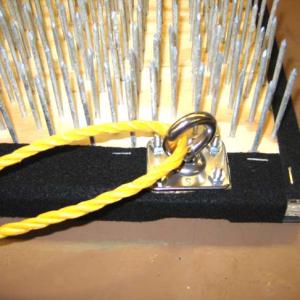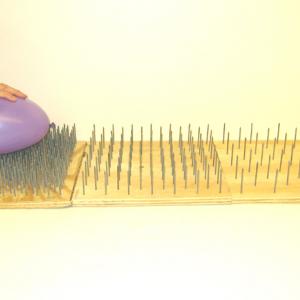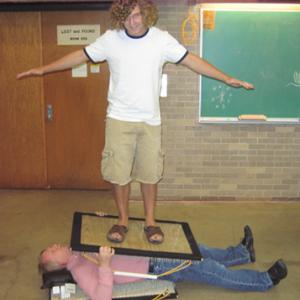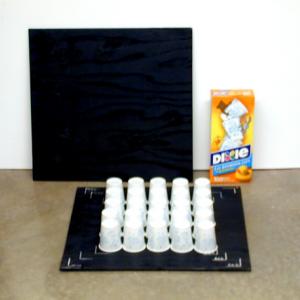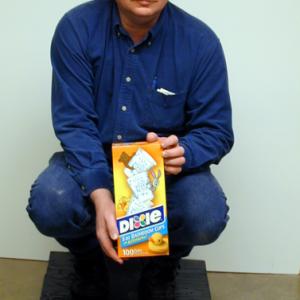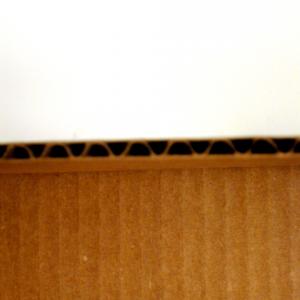College of Liberal Arts & Sciences
1K30.10 - Bed of Nails - Stand on Dixie Cups
Set one bed of nails on a table or the ground, place the pillow where your head will rest, and then have someone help lower you down onto the bed.
You can show the difference the density of the nails makes by using the small beds and pressing and rolling a balloon into them. The balloon won't pop until you get to the low density bed.
The single spike is for those brave soles who don't know their physics.
You can sandwich yourself between two beds of nails and have someone stand on you if you wish. It will take two people to lower the second be onto you and also someone to help the person onto the bed, steady them, and help them get off. Care should be taken that the person steps into the middle of the bed when getting on and doesn't try to jump off when coming down.
Arrange the Dixie cups in a 5X5, 6X6, or 7X7 array. Carefully have someone step up onto the top plywood platform, towards the center of the array that you are using. The 5X5 array should easily support 200 pounds or more. The reported crush strength of a single cup is supposed to be 16 pounds. The larger arrays will help protect against edge crushing if someone stepping onto the platform steps far off center.
This is similar to the construction of cardboard boxes. The ribbed construction of the boxes is supposed to support at least 80 pounds per square inch before crushing.
- Gordon P. Ramsey, "Building a Better Bed of Nails Demonstration", TPT, Vol. 42, #7, Oct. 2004, p. 438.
- Paul Hewitt, "Figuring Physics", TPT, Vol. 38, #3, Mar. 2000, p. 175.
- Ron Edge, "Strength and Shape", TPT, Vol. 25, # 1, Jan. 1987, p. 50.
- F- 037, "Stand on Balloons/Bulbs/Cups", Dick and Rae Physics Demo Notebook.
- M - 855, "Stand on Pepsi Can", Dick and Rae Physics Demo Notebook.
- 50 Fun Experiments for the Mad Scientist in You, "Sorting The Trash", National Geographic Kids, p. 50.
- David Kutliroff, "35, Fakir Physics", 101 Classroom Demonstrations and Experiments For Teaching Physics, p. 80.
- Vicki Cobb and Kathy Darling, "Quite a Ribbing", Bet You Can!, p. 30.
- Jearl Walker, "1.56, Beds of Nails", The Flying Circus of Physics Ed. 2, p. 29.
- Jearl Walker, "1.145, Crumpling Paper into a Ball", The Flying Circus of Physics Ed. 2, p. 69.
- Joey Green, "Dixie Cup Bridge", The Mad Scientist Handbook, Vol. 2, p. 25
- "Collapsing Soft Drink Can", Physics From the Junk Drawer, 3rd Edition, The Science House, North Carolina State University, p. 17.
- Tik L. Liem, "Crush The Can By Standing On It", Invitations to Science Inquiry - Supplement to 1st and 2nd Ed. p. 127.
- Julius Sumner Miller, Q219 & A219, Millergrams II – Some More Enchanting Questions for Enquiring Minds, p. 67 & 115.
- Julius Sumner Miller, Q225 & A225, Millergrams II – Some More Enchanting Questions for Enquiring Minds, p. 70 & 117.
Disclaimer: These demonstrations are provided only for illustrative use by persons affiliated with The University of Iowa and only under the direction of a trained instructor or physicist. The University of Iowa is not responsible for demonstrations performed by those using their own equipment or who choose to use this reference material for their own purpose. The demonstrations included here are within the public domain and can be found in materials contained in libraries, bookstores, and through electronic sources. Performing all or any portion of any of these demonstrations, with or without revisions not depicted here entails inherent risks. These risks include, without limitation, bodily injury (and possibly death), including risks to health that may be temporary or permanent and that may exacerbate a pre-existing medical condition; and property loss or damage. Anyone performing any part of these demonstrations, even with revisions, knowingly and voluntarily assumes all risks associated with them.

